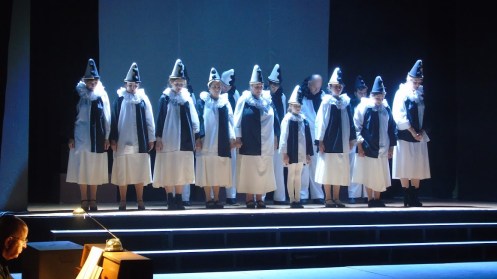Barnes, Barnes Community Players, BCP, England, Haig, horror, Joan Littlewood, military, Oh What a Lovely War, Pack up Your Troubles, politics, violence, war, World War 1, WWI
Oh What a Lovely War
Military Engagement
Oh What a Lovely War
by Charles Chilton, Gerry Raffles and members of Theatre Workshop
Barnes Community Players, Kitson Hall, Barnes until 9th June
Review by Eleanor Lewis
Recently, at a fundraising vintage tea party in a hospice, we (the ‘entertainment’ i.e. a rather under-rehearsed group of singers), sang a selection of war-related songs including a version of Pack up Your Troubles in which the line “While you’ve a Lucifer to light your fag,” had been replaced with another one which didn’t mention the “fags”. It was a kind, well-intentioned attempt to remove any mention of cigarettes and the damage they do, but it was awfully confusing during the sing-along, particularly for the senior citizens present.
I remembered this event during Barnes Community Players’ production of Oh! What a Lovely War on Tuesday evening at Kitson Hall and wondered what the WWI generation might have thought about the neurotic fear we all now have of offending anyone, anywhere, at any point. Their sacrifice, their experience doesn’t really bear comparison.
Joan Littlewood’s 1963 Oh! What a Lovely War was born out of her dissatisfaction with a play which attempted to communicate the First World War. The play itself she disliked, but it did inspire her to send off a group of actors to research the war. On their return, she and they created a show together by improvising with the information and stories they had found. It was entitled Oh! What a Lovely War and their improvisations constitute the show that is performed today. In a similar way as the slightly later Cabaret shocks its audience midway with a chilling, choral rendition of Tomorrow Belongs to Me, Oh! What a Lovely War creates an end-of-the-pier show atmosphere until close to the end of Act I when explosions and reality start to become relentless.
Oh! What a Lovely War changed the tone of public reaction to WW1, it entertained and educated. It showed the dearth of intelligence in strategic planning, it was horribly revealing of General Haig and it addressed the shocking reality of the common soldiers’ lives. It was also a living thing, the company took it to America later in the ‘60s and made adaptations to take in the Vietnam War.
The show itself is a collage of small sketches against a back projection of photographs and statistics charting the progress of the war. All the actors play a series of small parts, soldiers, working girls, suffragettes and others, and sing songs of the time. This is not the easiest of shows to put on and Barnes Community Players, leaving aside a few first night nerves, rose to the challenge sufficiently well to deserve their enthusiastic applause.

The production stuck to the original Pierrot costumes, using hats, caps, military and other props to indicate a change of character, with occasional full costume set pieces as in the artfully designed corset and lace underwear ensembles for the rendition of I’ll Make a Man Out of You.
Oh! What a Lovely War is not a piece with principal roles like other shows, but for the sake of simplicity, the chorus in this production was a little stronger than the principals. Chris Mounsey, Ben Jeffery, Joanna Harry and Symeon Wade in particular brought an appealing animation to each little role they had. Clare Farrow’s clear and engaging speech from a soapbox as Mrs Pankhurst was quite a treat. Almost all performers had significant amounts of lines and moves and were required at all times to provide convincing ‘background’. ‘Background’ (chorus work) is always challenging and the show falls if it’s not strong.
Barnes Community Players do not have this problem; everyone on stage had a convincing character whether or not they were at the centre of the action and as a group they acquitted themselves very well and created a lot of atmosphere.
The music, directed by Simon Douglas Lane, was a great asset to this production. It was highly appropriate, a piano, drums and percussion providing yet more atmosphere and maintaining a lively pace which helped the production move along briskly. There was in fact a great deal of atmosphere to this production – the simple fact of its being performed in an English church hall counted for quite a lot but Martin Walton’s lighting and Joanna Field’s sound including the sound of shelling and explosives added a great deal without being excessive.
This ground-breaking piece of theatre is possibly the most appropriate way of remembering a shocking period of history. Photographs, statistics and information on the back projection and in the Director’s Note (which I think is lacking a couple of references: Michael Billington and Matthew Sweet, 2014) are in themselves difficult to process in today’s world: “We’re losing between five and fifty thousand men a day”, not being the worst of them.
Barnes Community Players are to be commended for taking on this work and for performing it so well and with an evident respect for the material itself.
Eleanor Lewis
June 2018
Photography courtesy of Barnes Community Players
Leave a comment Cancel reply
This site uses Akismet to reduce spam. Learn how your comment data is processed.
